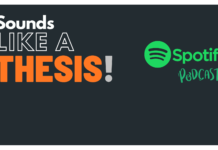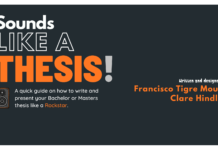Has the following scene ever happened to you?
You are at home practicing a pentatonic scale on a Yamaha guitar. You’ve been working on it for an hour and you are clearly improving, clearly in the zone!
Suddenly your mom arrives home from work. Then, she asks you a very tricky question: Do you want to know what happened to me at work today?
You stop playing the guitar and think to yourself: If I say “YES”, I’ll have to listen to a story that will last about an hour. I will not understand it fully because I don’t know the people she will mention and later it will be too late to keep practicing the guitar…
But because you don’t want to let her down, you tell her: “Tell me mom”…
Meanwhile your mind is thinking: “PLEASE get straight to the point! Just tell me the relevant parts! Don’t give me the extended version of the story, like always. PLEASE be brief!”
This is exactly how a great ABSTRACT should be!
Abstracts should briefly explain a study without missing any of the relevant information. Anyone should be able to read it and know exactly what the study was about. If the reader can’t achieve this, you should re-write your abstract.
Ps: It is just like in music: “Don’t bore us, get to the chorus!”
Soooo, to me a GREAT ABSTRACT should contain the following content:
-
The AIM or OBJECTIVE of your study
- What was your study trying to investigate?
-
The METHOD (s) used in the study
- Which method (and/or research design) did you use to conduct your study and achieve your aim?
-
The SAMPLE size (number and profile of respondents) of your study
- Who participated in your study? How many respondents/participants? Or how many elements did you analyze?
-
Brief summary of FINDINGS and discussion
- What was/were the most important finding (s)?
- Contribution of your study
- How does your study contribute to the existing literature and/or to your industry?
These five points are present in every empirical study and in essence are the most important sections.
EXAMPLE
Here is an abstract that I wrote for a paper titled “Localizing Cultural Values on Tourism Destination Websites: The Effects on Users’ Willingness to Travel and Destination Image“, and was published in 2014 by the highly prestigious JTR – Journal of Travel Research.
Ps: The maximum amount of words allowed by JTR for an abstract is 150.
Here is the abstract I wrote for it:
“The present study contributes to the current localization literature by revealing the effects of localizing cultural values on tourism destination websites on users’ destination image and willingness to travel. Reporting on two tests, the first is an analysis of the depiction of cultural values on 48 New Zealand, 36 Indian, and 46 Chinese destination sites. Results indicate significant differences in the cultural values exposed among the three countries. The second study reports on an experiment requiring 400 New Zealand participants to visit four versions of a fictitious experimental destination website. Commensurate with motivations for holiday tourism, results indicate that the depiction of incongruent cultural values to a target audience on destination websites generates a more positive destination image and greater willingness to travel, contradicting the current localization literature. Finally, managerial implications are also discussed“.
This was an exceptionally long study. It involved two stages, large funding, many sites analyzed and a great deal of participants. Nonetheless, everything was summarized in less than 150 words.
Here is how I addressed all 5 main points of the study:
1. The AIM or OBJECTIVE of the study
“The present study contributes to the current localization literature by revealing the effects of localizing cultural values on tourism destination websites on users’ destination image and willingness to travel.”
Comment: As you can see, it is very straightforward (Just like I wish my mother was every time she wanted to tell me a story).
- Did I provide an explanation of why I defined this aim?
- No. There is no time here for it.
- Is it clear what the study is about?
- I hope so. At least it should be for people in the field that are familiar with the topic. If the reader wants to know any further information he/she will read the paper!
2. METHOD and SAMPLE size (number and profile of respondents) of the study
Reporting on two tests, the first is an analysis of the depiction of cultural values on 48 New Zealand, 36 Indian, and 46 Chinese destination sites. Results indicate significant differences in the cultural values exposed among the three countries. The second study reports on an experiment requiring 400 New Zealand participants to visit four versions of a fictitious experimental destination website.
Comment: Here I tried to clarify some things in regards to methods and sample:
- The paper contained two studies
- Study one:
- The number of sites and country investigated
- Brief result of the first study
- Study two:
- The method and number of experimental conditions
- Number of participants and where they were from
3. Brief summary of FINDINGS and discussion/ and 4. Contribution of the study
Commensurate with motivations for holiday tourism, results indicate that the depiction of incongruent cultural values to a target audience on destination websites generates a more positive destination image and greater willingness to travel, contradicting the current localization literature. Finally, managerial implications are also discussed“.
Comment: Here I tried to summarize all results into one single statement. This is certainly one of the most challenging things you will ever do.
But you must always be able to explain in simple terms what your study has found!
Finally, one important observation:
- By stating that “the results contradicted the existing literature” I have revealed to the reader the main contribution of the paper.
Final Thoughts
To have a fantastic abstract I believe you should:
- Have included the most relevant information of your paper
- Research Aim/Objective/Research Question/main hypothesis (depends how you structured your study)
- Research method
- Sample size and profile of participants (or what you have analyzed)
- Summary of findings
- Contribution of your study
2. Have written it clearly and objectively
3. Have respected the word count defined by the organization you will submit your work to.
But next time your mom comes to tell you a story while you are practicing the guitar, don’t ask her for the abstract of the story!
Oh, and if you want to thank me for these incredible tips by sending football jerseys: In Germany I support the fantastic Borussia Dortmund.





